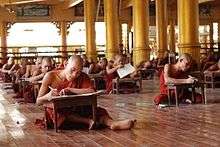Monastic examinations

Monastic examinations comprise the annual examination system used in Myanmar (Burma) to rank and qualify members of the Buddhist sangha, or community of Buddhist monks. While the institution of monastic examinations first began during pre-colonial era,[1] modern-day examinations are conducted by the Ministry of Religious Affairs's Department of Religious Affairs.[2]
History
The institution of monastic examinations date to the pre-colonial era. Burmese monarchs used these examinations to encourage the study of Pali, the liturgical language of Theravada Buddhism.[3] Successful candidates were rewarded with royal recognition, titles and ranks, and monastic residences.[3]
The pathamabyan examinations began in 1648 during the rule of King Thalun of the Taungoo Dynasty.[2] King Bodawpaya of the Konbaung Dynasty standardized the existing set of examinations, and introduced new ones related to the Vinaya.[4]
This system temporarily lapsed following the demise of the Konbaung Dynasty in 1886, but was revived by the colonial Directorate of Public Instruction to encourage theological and secular education in Burmese monasteries.[3] After a few years of resistance by the Burmese sangha, the first series of colonially-administered examinations was successfully launched in June 1895.[3] They were held annually in Mandalay, Rangoon, and Moulmein.[3] Successful candidates were certified as pathamagyaw.[3]
Government examinations
Monastic examinations are divided into multiple grades, based on level of difficulty. Monks that pass each succeeding examination are eligible to sit for the next highest-level examination.[5] Monastic exams are held during the Burmese month of Nayon. Examination content is drawn from Buddhist texts drawn from the Abhidhamma Pitaka, Vinaya, and Sutta Pitaka.[5] Questions require candidates to replicate passages from memory, to analyze specific text, and to correct Pali grammar.[5]
Pathamabyan examinations
The Pahtamabyan (ပထမပြန်စာမေးပွဲ) examinations, the lowest-level series of examinations, comprise three exams, from lowest to highest difficulty:
- Pathamange examination (ပထမငယ်စာမေးပွဲ)
- Pathamalat examination (ပထမလတ်စာမေးပွဲ)
- Pathamagyi examination (ပထမကြီးစာမေးပွဲ)
Candidates who rank first on the Pathamagyi examination are known as pathamagyaw (ပထမကျော်).
Dhammācariya examinations
Dhammācariya examinations (ဓမ္မာစရိယစာမေးပွဲ), the mid-level series of examinations. Candidates for these examinations are required to pass all three components of the Pathamabyan examinations. The examinations are held over the course of nine days, including six days covering the base texts, one day covering Burmese language texts, and two days for Pali language texts.[6]
Successful candidates are bestowed the monastic title of Dhammacariya (Pali for "teacher of the Dharma").[5]
Tipiṭakadhara and Tipiṭakakovida examinations
The Tipiṭakadhara and Tipiṭakakovida examinations (တိပိဋကဓရ တိပိဋကကောဝိဒ ရွေးချယ်ရေးစာမေးပွဲ), held since 1948, are the highest-level examinations conducted by the Burmese government. These examinations, require candidates to demonstrate rote memory and comprehension of the entire Pāli Canon and its relevant commentaries, sub-commentaries, and treatises.[7] The oral and written examinations are held annually in December, over the course of 33 days at the Kaba Aye Pagoda's Mahapasana Cave in Yangon.[5][8] The breadth of the examinations requires candidates to recite over 2.4 million words with correct pronunciation and smooth flow, and transcribe over 200 texts from memory.[9] The examinations also require candidates to display their mastery of "doctrinal understanding, textual discrimination, taxonomic grouping and comparative philosophy of Buddhist doctrine."[8] The first candidate to pass the Tipiṭakadhara examinations was Mingun Sayadaw in 1953.[10] As of 2013, only 12 monks have passed these examinations.[8]
Successful candidates are bestowed ranking titles, depending on their performance.
Private examinations
Two monastic organizations in Burma also conduct annual Dhammacariya examinations, including the Sakyasīha Examination (သကျသီဟ) sponsored by Mandalay's Pariyatti Sasana Association, and the Cetiyaṅgaṇa Examination (စေတိယင်္ဂဏ ပရိယတ္တိ ဓမ္မာနုဂ္ဂဟ စာလျှောက်မေးပွဲ) sponsored by the Board of Trustees of Shwedagon Pagoda.[5][11] Monks who pass these examinations are bestowed a monastic title, -abhivaṃsa (အဘိဝံသ, literally "noble lineage"), which is suffixed to their monastic name.[12]
Successful candidates of the latter examination are bestowed the Cetiyaṅgaṇa Pariyatti Dhammācariya Gaṇavācaka (စေတိယင်္ဂဏ ပရိယတ္တိ ဓမ္မာစရိယ ဂဏဝါစက) and Cetiyaṅgaṇa Abhivaṃsa (စေတိယင်္ဂဏ အဘိဝံသ) titles. Successful candidates are qualified to sit for the government's Tipitakadhara and Tipitakavida examinations.[13]
Monastic titles
Candidates successfully passing the Dhammācariya and higher-level examinations are bestowed ranking titles, as listed below (in order of decreasing precedence):
- Tipiṭakadhara and Tipiṭakakovida examination titles[10]
- Dhammabhaṇḍāgārika (ဓမ္မဘဏ္ဍာဂါရိက, "Keeper of the Dhamma Treasure")
- Maha Tipiṭakakovida (မဟာတိပိဋကကောဝိဒ, "Great Bearer of the Tipitaka (oral and written)")
- Tipiṭakakovida (တိပိဋကကောဝိဒ, "Bearer of the Written Tipitaka")
- Abhidhammākovida (အဘိဓမ္မကောဝိဒ)
- Tipiṭakadhara (တိပိဋကဓရ, "Bearer of the Spoken Tipitaka"))
- Abhidhammika (အာဘိဓမ္မိက)
- Dīghanikāyakovida (ဒီဃနိကာယကောဝိဒ)
- Dīghabhāṇaka (ဒီဃဘာဏက)
- Vinayakovida (ဝိနယကောဝိဒ)
- Vinayadhara (ဝိနယဓရ)
- Dhammācariya examination titles[6]
- Dhammācariya Makuṭiraṃsī (ဓမ္မာစရိယမကုဋရံသီ)
- Sāsanadhajadhammācariya Abhidhammā Paḷi Pāragū (သာသနဓဇဓမ္မာစရိယအဘိဓမ္မပါဠိပါရဂူ), Sāsanadhajadhammācariya Dīghanikāya Paḷi Pāragū (သာသနဓဇဓမ္မာစရိယဒီဃနိကာယပါဠိပါရဂူ), and Sāsanadhajadhammācariya Vinaya Paḷi Pāragū (သာသနဓဇဓမ္မာစရိယဝိနယပါဠိပါရဂူ)
- Sāsanadhaja Sirīpavaradhammācariya (သာသနဓဇ သိရီပဝရဓမ္မာစရိယ)
- Sāsanadhajadhammācariya (သာသနဓဇဓမ္မာစရိယ)
References
- ↑ "Festivals in Burma (Myanmar) - Asian and African studies blog". blogs.bl.uk. Retrieved 2016-11-13.
- 1 2 "သာသနာရေးဦးစီးဌာနက ကျင်းပသည့် စာမေးပွဲများ". Department of Religious Affairs (in Burmese). Ministry of Religious Affairs. Retrieved 2016-11-13.
- 1 2 3 4 5 6 Smith, Donald Eugene (2015). Religion and Politics in Burma. Princeton University Press. ISBN 9781400878796.
- ↑ Dhammasami, Khammai (2004). Between Idealism and Pragmatism: A Study of Monastic Education in Burma and Thailand from the Seventeenth Century to the Present (PDF). St. Anne’s College, Oxford University.
- 1 2 3 4 5 6 Johnston, William M. (2013). Encyclopedia of Monasticism. Routledge. ISBN 9781136787164.
- 1 2 "ဓမ္မာစရိယစာမေးပွဲ". Department of Religious Affairs. Ministry of Religious Affairs. Retrieved 2016-11-14.
- ↑ Aung Thein Nyunt. "A STUDY OF TIPITKADHARA SELECTION EXAMINATION IN MYANMAR (1948-2007)". The International Association of Theravāda Buddhist Universities. Retrieved 2016-11-13.
- 1 2 3 Kawanami, Hiroko (2013). Renunciation and Empowerment of Buddhist Nuns in Myanmar-Burma: Building a Community of Female Faithful. BRILL. ISBN 9004234403.
- ↑ "TIPITAKADHARA SAYADAWS OF MYANMAR ( BURMA ) IN FIVE DECADES". Nibbana.com. 2014-10-23. Retrieved 2016-11-13.
- 1 2 Harris, Ian (2007). Buddhism, Power and Political Order. Routledge. ISBN 9781134129478.
- ↑ စကား၀ါ (25 January 2016). "Monday, 25 January 2016 10:24 ရွှေတိဂုံ စေတီတော် စေတိ ယင်္ဂဏ ရာပြည့် ပွဲတော် ကျင်းပမည်". Myawaddy (in Burmese). Retrieved 2016-11-13.
- ↑ Sayadaw U Pandita. "One Life's Journey". vmc128.8m.com. Retrieved 2016-11-14.
- ↑ "တိပိဋကဓရ တိပိဋကကောဝိဒ ရွေးချယ်ရေးစာမေးပွဲ (ရေးဖြေ) ကျင်းပနေပုံ". Department of Religious Affairs (in Burmese). Ministry of Religious Affairs. Retrieved 2016-11-13.